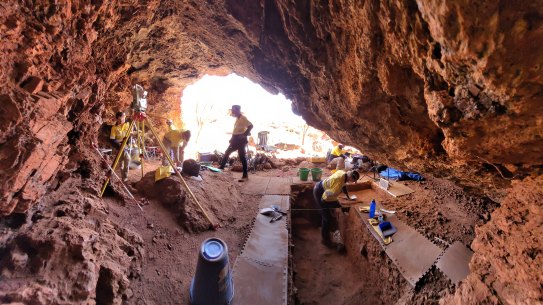Breaking News: Devil’s Tooth Found in the Stunning Discovery at Juukan Cave Site!
A Tasmanian devil tooth, artefacts and braided hair are among the “mind-blowing” finds from excavations of 46,000-year-old indigenous rock shelters in Western Australia destroyed by mining.
The Juukan Gorge caves in the Pilbara were blown up in May 2020 by Rio Tinto, devastating traditional custodians and causing global outrage.
Re-excavations of the Juukan-2 rock shelter have been underway for almost two years.
The work has unearthed braided human hair, a Tasmanian devil tooth, shell beads, resin-bound quartz artifacts, and several special crescent-shaped stone artifacts.
Puutu Kunti Kurrama (PKK) Land Committee chair Burchell Hayes said the findings further demonstrate the extreme cultural and scientific importance of Juukan Gorge.
“These important discoveries… have the potential to rewrite what we know about the Pilbara’s deep past,” he said on Tuesday.
Excavations in 2008 and 2014 uncovered 5,000-year-old braided human hair, a sharpened kangaroo bone, and thousands of other important cultural materials.
Excavation director and associate professor Michael Slack said some of the individual items excavated were enough to make the site highly significant.
“The fact that we have a collection of these items from a small part of the planned excavation proves what the PKK people have been saying all along: that this is a very special and important place,” he said.
Professor Slack said there was no previous physical evidence of Tasmanian devils living in the Pilbara and the last evidence of the marsupial existing in WA was in the south-west of the state, 3000 years ago.
“We excavated a really diverse range of artifacts in 2014 and we have added more rare artifacts to the assemblage through this excavation, such as the shell bead,” he said.
“Finding this is evidence that people who lived here visited or traded with people who lived on the coast hundreds of miles away.”
The Puutu Kunti Kurrama Pinikura Aboriginal Corporation is working with Rio Tinto to rehabilitate the land.
“We weren’t sure how extensive the damage was until we got to work,” said the corporation’s director of land and heritage management, Jordan Ralph.
“While the rock shelter structure was destroyed, it is pleasing to see that the archaeological deposit is largely intact and was not significantly disturbed by the explosion.”
The new excavation has focused on approximately a quarter of the shelter floor in an area that had not been previously worked.
The project is expected to last at least another 12 months, with the latest findings to be presented at the Society for American Archaeology conference in New Orleans this weekend.
The cave’s destruction prompted an apology from Rio Tinto, a parliamentary inquiry and new Aboriginal heritage laws in WA.
Related Post
The entire tomb is filled with signs and symbols that mention Queen Nefertiti and after some time passed and linguistic experts managed to decipher the stories told here, the team was baffled.
The mystery of the Solar Temple of Abu Gurab and its “Star Gate” comes to light
Thuya, the mother of Queen Tiye, left a monumental legacy by becoming the grandmother of Akhenaten and Tutankhamun.
The oldest traditions lead us to believe that blacks were the first inhabitants of Mexico.
The REAL face of King Tut: The pharaoh had feminine hips, clubfoot, and protruding teeth according to the ‘virtual autopsy,’ which also revealed that his parents were brother and sister.
The “oldest gold of humanity” was found in the Varna necropolis, on the Bulgarian Black Sea coast

